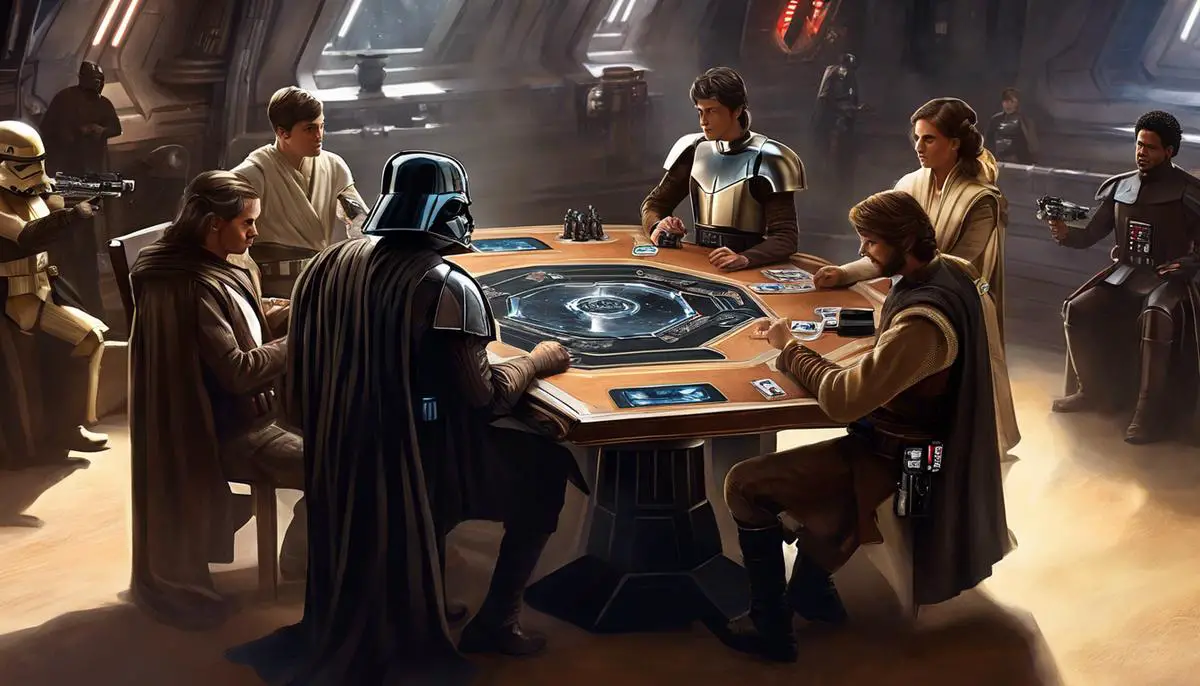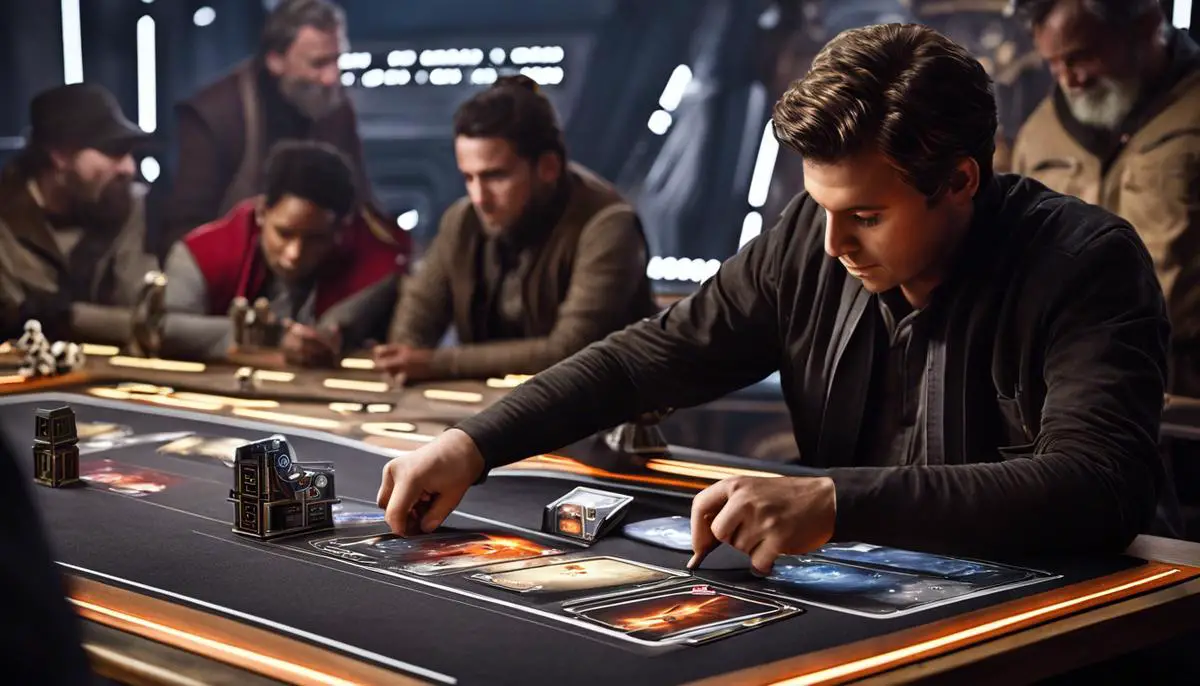Triggering an escapade to the galaxy far, far away, Star Wars: The Deckbuilding Game opens an immersive portal, inviting players into a strategy-infused universe. This arena is intertwined with captivating narratives, card synergies, and viable strategies as intricate as the web beneath the Force itself. Riding on the subtly weaved nuances of this captivating game and acting as a comprehensive guide, this essay takes you on a meticulously curated expedition. It offers deep insights into the game’s core mechanics, unravels the strategic rigors involved, and goes beyond the cards themselves to engage the vibrant community that revolves around it. Whether you are tentatively taking your first steps into this galaxy, or are a seasoned player looking to brush up on your understanding, this piece illuminates diverse facets of this enthralling deckbuilding game.
Basics of The Deckbuilding Gameplay
The Cornerstones of Stellar Deckbuilding Strategy in Card Games
Forgetting the complexities of any card game for a moment, let’s simplify things and compare a freshly crafted deck to a the key ingredient of a perfect pizza pie: its crust. After all, like a crust, a well-constructed deck forms the base for exciting gameplay, with its strategies sprinkled atop it like delicious toppings. But how does one create this gaming equivalent of the perfect pizza crust?
First and foremost, the core of any deckbuilding strategy lies in understanding individual card interactions. Delving deep into how cards synergize with each other can pave the way for explosive plays that’ll sweep opponents clean off their feet. Having a few pairs of cards that work together exceptionally well can often make the difference between victory and defeat. So, keep an eye out for cards that unlock potent synergies and strategies.
Then comes card ratio. Just like too much or too little of an ingredient can spoil your pizza, too many or too few of a card type can derail your deck’s performance. Analyze your deck’s structure carefully. Are there enough low-cost cards to ensure a healthy start to the game? Are powerful, high-cost cards sprinkled in moderation to ensure a dramatic finish but without being a constant drag in your hand for half the game? Achieve this delicate balance, and you’re on the right deckbuilding track.
The delicate dance of resource management forms the next facet of our deckbuilding discussion. A lot of card games have mechanics like Mana, Energy, or Gold, which limit what you can play each turn. Thus, maintaining an efficient curve of cards in relation to their cost can help ensure that you’re always able to play something meaningful every turn.
A point that’s often overlooked in deckbuilding but is just as important is anticipating your opponent’s playstyle and deck’s composition. Just like a chef anticipating a customer’s palate, players should hold a few counter-cards in their decks to stifle opponents. These “tech” cards, while not always synergizing with your deck’s primary strategy, can provide essential disruption to your opponent’s plans, giving you the upper hand.
Lastly, practice makes perfect – both in pizza-making and deck building. No matter how theoretically solid your deck seems, it’s only by playing games and refining the deck that you’ll truly perfect your craft. Consider each game a test run and persistently tweak your deck, paying close attention to where it performs well and where it falls short.
That’s the essence of deckbuilding: a strategic blend of synergies, card ratios, resource management, anticipation, and practice. Each deck you craft should be like a personal, perfect pizza recipe, tailored to your taste and style. May your deckbuilding journey bring victories, insights, and a whole lot of fun!

Understanding Strategy in Star Wars: The Deckbuilding Game
Strategic Chess Moves for Beginners and Pros in the Game of Magic: The Gathering
Venturing into the mesmerizing world of Magic: The Gathering (MTG) is no less than setting foot on a battlefield. The thrill and the anticipation is all real. The arena is laden with numerous considerations for both rosy beginners and seasoned pros, guaranteeing that each match is a galore of emotions and strategies. Moving beyond the basic foundations such as understanding card synergies, balancing your deck, managing resources, and anticipating the opposition’s play style, we shall dive into the deeper waters to discuss some more comprehensive strategies required to master this enchanting game.
First and foremost, no deck is unbeatable. Many new players often overlook this concept, getting overly frustrated or disheartened with defeats. Be it a beginner or an expert, when venturing into a match, it’s essential to remember that every deck, no matter how well-constructed, has weaknesses that can be exploited. This understanding, when tied with your knowledge of card interactions and your capability to anticipate opponent moves, can assist you in identifying opportunities for victory even in the direst situations.
Secondly, understanding your deck profile and your opponent’s deck profile is a cornerstone of MTG. This goes beyond knowing your cards and theirs – it’s about understanding the overall strategy your deck is designed to execute, and the possible tactics your opponent might use based on their deck. This understanding can offer crucial insights into cards that might have particular significance in any given match.
Thirdly, the mulligan rule, where you can re-draw your starting hand if it’s unfavorable, is an excellent addendum to the game. Using it strategically can turn around the tide of the battle. Knowing when to invoke the mulligan can make the difference between a victory and a defeat, even before the first move is made.
Yet another important element of MTG strategy is the understanding of timing. When to play a card is just as crucial as knowing which card to play. Some cards have maximum effect when played at the right moment and understanding their mechanics can allow a player to control the pace of the match.
Lastly, always moving with a plan B is prudent in any strategic game, and so is the case with MTG. Decks are designed with primary and often secondary and tertiary plans for winning. If your main strategy is getting countered by your opponent, being able to swiftly shift to a Plan B could save you in the knick of time.
Remember, MTG is a game of mental prowess and strategic genius. Every defeat is a chance to learn, and every win fortifies your strength. So, grab your deck, shuffle your cards, and be ready to cast your best magic, because the mystical world of MTG springs eternally fascinating tales of victory and learning at every turn.

Card Categories and Their Roles
Title: How Card Categories Shape Gameplay and Strategy in Star Wars: The Deckbuilding Game
Richly thematic, and effortlessly combining strategy and luck, Star Wars: The Deckbuilding Game offers players a chance to immerse themselves in the expansive Star Wars universe. Dive deeper into this compelling game as we unearth the role of different card categories in shaping gameplay and moulding strategies for both new players and battle-hardened veterans.
One of the key elements of the game is its diverse card categories. Yes, we are referring to the very heart of the game: the event cards, the objective sets, fate cards and the unit cards. These categories define the tempo of the game, dictating a player’s approach towards building strategies and driving gameplay forward.
First up, we have our event cards. Armed with one-time effects, these cards prove to be game-changers when played right. While they offer powerful abilities that can tilt the game in your favor instantly, they also require a rage for usage which means they demand careful resource management. Having event cards in your deck not only provides the scope for tactical maneuvers but also adds a level of uncertainty and unpredictability to the game.
Next in line are the objective sets – the foundation of your deck. Each objective set contains a unique mix of units, enhancements, and events that span across multiple categories. This combination forces players to adopt a strategic approach towards deck construction. Selecting the right balance of objective sets is crucial for formulating the game plan, whether you wish to go offensive, defensive or opt for a balanced approach.
Included among the stars of the game are fate cards. When conflicts arise in engagements, these cards come into play, allowing players to tweak the outcome of an edge battle. Although they contribute no forces to the engagement, their special abilities could potentially swing the scale in your favor. A good understanding of these cards can give you the upper hand during this critical phase of the game.
Last but certainly not least are unit cards. These are your foot soldiers, leading your assault against your foes or defending your objectives from enemies. The diversity in unit cards is impressive, ranging from Jedi and Sith to droids and vehicles, each with its unique abilities. Having a diversified unit composition not only enriches your deck but also offers more tactical flexibility in responding to various situations during the game.
Star Wars: The Deckbuilding Game invites players to explore various strategic paths shaped by the card categories. Whether it’s the event cards infusing unpredictability, the objective sets driving strategic planning, fate cards influencing edge battles, or unit cards offering flexibility, each category contributes uniquely to the gameplay. So, feel the Force, align your deck, and let the strategic intergalactic warfare begin!

Engaging with the Star Wars: The Deckbuilding Game Community
Expanding your experience with Star Wars: The Deckbuilding Game is not just limited to learning card mechanics or perfecting strategies. Often, the best way to enrich your understanding of the game and bring your gameplay to the next level is by immersing yourself in the game’s community. Being part of the community amplifies the playing field, offering a different kind of education reserved only for those who dare to explore beyond the deck.
One of the first things you’ll find when joining the community is that it is rife with shared experiences. Players are all too willing to recount their battles, delving into details of the moves they made, choices they regret, and the victories and defeats that resulted from these decisions. These stories act as an invaluable source of insight into novel tactics and strategies you may not have considered.
Joining a playing group within the community, be it casual or competitive, can vastly improve your understanding of the game as well. Fellow players are likely to spot nuances in your playing style that you might have missed. A player’s blind spots are often illuminated in group sessions, fostering growth and improvement.
The community is also an excellent source of clarification and interpretation for game rules. Despite our best efforts, we may misunderstand or misinterpret a rule, potentially costing us a round or even a game. In a community setting, misunderstandings can be swiftly rectified, thanks to the collective knowledge of the group.
Communities inevitably comprise various experience levels, from novices to battle-hardened veterans, making them a goldmine of tips and advice. More experienced players usually possess the wisdom to offer perspective and instill patience, especially useful when the enjoyment of the game might be shadowed by a series of defeats. They remind us that building a strong deck and honing a winning strategy is not an overnight achievement.
Within the game’s community, cultural exchange plays a major role too. Star Wars has a global fandom, and so does the Star Wars: The Deckbuilding Game. Engaging in cultural exchange with players worldwide broadens horizons, enriches the game’s context, and can result in fascinating adaptations of strategies.
Finally, the camaraderie found within the game’s community provides a sense of belonging and a shared enthusiasm. This communal spirit enhances the gaming experience to more than just a battle on a tabletop, but rather a journey in a galaxy far, far away. And isn’t that the true essence of being bound by a shared love of Star Wars: The Deckbuilding Game?

Updates and Expansions: Keeping up with the changes
With each new update, expansion, or new edition of Star Wars: The Deckbuilding Game, gameplay and strategies evolve and intensify. New cards are introduced, altering the dynamics of the game and prompting players to rethink their approaches and adopt fresh strategies.
First up, the addition of new expansions frequently results in the game’s expanded arsenal. Novel cards often equip players with unique abilities and open the door for innovative strategies or enhance existing ones. Consider these additions as tools for fine-tuning, providing not just more variety but more impactful decisions. With every new card, there’s potential for fresh interactions and synergies to explore.
Furthermore, updates regularly modify existing game rules or introduce new ones. These slight but significant changes can drastically affect gameplay. For instance, modifications in how resources are gained or spent may inspire players to reconsider their resource management strategies. Adaptability is key here. Players who can adjust their gameplay according to evolving rules are likely to have an edge over those who rigidly cling to old strategies.
Expansions also bring thematic diversity to familiar gameplay. They usually focus on a specific element or era of the Star Wars universe, sometimes enforcing theme-oriented gameplay adjustments. This not only stimulates fresh strategies but also adds a layer of interest into the game universe, especially for fans of specific characters or timelines.
An often overlooked aspect of updates and expansions is their impact on deck diversity. With added cards in circulation, the possibility of encountering a wider array of deck profiles increases. This necessitates players to stay on their toes and have multiple backup strategies in their arsenal. This diversity also contributes to the long-term replay value of the game, ensuring that no two games will ever be identical.
Lasty, one may find their relationship with the playing community strengthened through these updates and expansions. As experienced players analyse and share their insights about new additions, beginners and intermediate players can learn, thereby levelling the playing field. This exchange of tactical creativity and collective problem-solving aids in building a strong, vibrant player community.
Without a doubt, updates, expansions, and new editions are a vital part of Star Wars: The Deckbuilding Game. They keep the game fresh and exciting, continually challenging players to adapt and evolve their strategies. Foster an open mindset, view each change as an opportunity for growth, and continue to enjoy the rich, endlessly fascinating world of Star Wars deckbuilding. Happy gaming, folks!

As the last piece of the Star Wars: The Deckbuilding Game puzzle falls into place, it encapsulates not just a game, but an engaging, ever-evolving experience. It’s an experience that calls for continuous learning, acute awareness, and honed strategizing – propelling players onto a journey that mimics the thrill of the Star Wars universe. More than comprehending the game’s mechanics or mastering card categories, the journey is about adapting to the updates, being part of the fervor in its community, and shaping your own narrative. Stepping away from just the game board, Star Wars: The Deckbuilding Game forges ahead, presenting an expansive universe that continually celebrates strategic agility, constant adaptation, and most importantly, the enduring power of the Force. So, brace yourself for the journey, and may the Force be with you.
